Insect legs and it's modifications
7 likes5,037 views
This document discusses the different types of modifications to insect legs. It begins by describing the basic structure of insect legs, which generally consist of five segments from proximal to distal: coxa, trochanter, femur, tibia, and tarsus. The document then describes seven main types of leg modifications: saltatorial (jumping), raptorial (seizing), fossorial (digging), natatorial (swimming), cursorial (running), scansorial (climbing), and ambulatorial (walking). Each modification type is adapted for a different locomotive function and examples are provided of insects that exhibit each leg type.
1 of 8
Downloaded 30 times

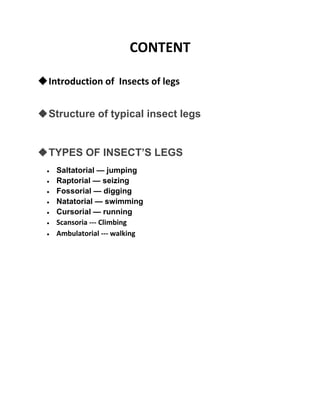
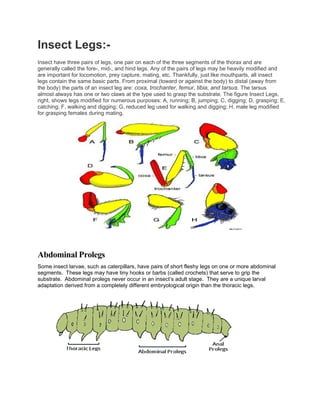
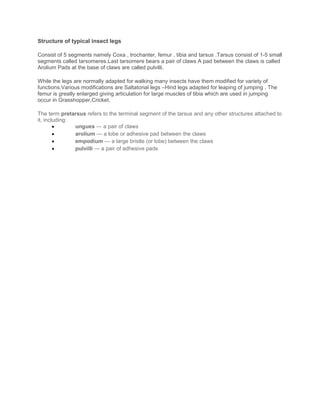
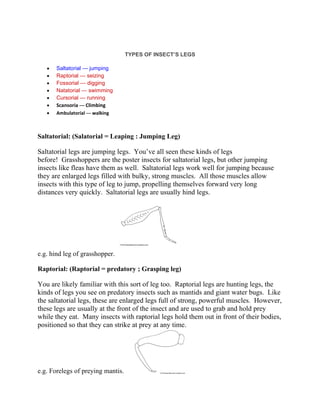



Recommended
Order: Collembola and Diplura



Order: Collembola and DipluraMelusinaNorwood
╠²
Collembola, commonly known as springtails, are small wingless arthropods that use a furcula, or springing organ, to jump. They lack eyes and have four segmented antennae. An adhesive collophore on their first abdominal segment helps with water balance. A retinaculum holds the furcula beneath their body. Malpighian tubules and tracheal systems are usually absent. Diplura are also small soft-bodied soil-dwelling insects that feed on dead organic matter. They have many segmented antennae and chewing mouthparts. Paired appendages are present on their abdominal segments and their tarsi are one segmented.Order hemiptera



Order hemipteraNavneet Mahant
╠²
1. This document provides information on the course Fundamentals of Entomology II, including definitions and characteristics of different orders of insects including Hemiptera and Homoptera.
2. It describes key features and examples of different families of true bugs and plant-sucking insects like aphids, whiteflies, and scale insects.
3. The insect orders and families discussed include agricultural pests that feed on and transmit pathogens in important crop plants.Head



HeadAnil kumar
╠²
This document summarizes the key structures and features of insect heads and mouthparts. It notes that the insect head contains sensory organs, feeding appendages, and a major neuroendocrine center. The main mouthpart types are mandibulate (chewing), haustellate (piercing and sucking), and sponging. Mandibles and maxillae are used for chewing food, while haustellate mouthparts contain stylets for piercing tissues and sucking fluids. Antennae are segmented sensory organs located on the head that come in various shapes and serve to detect odors, sounds and other stimuli.Insects orders



Insects ordersBahuddin Zakariya University, Multan
╠²
This document provides information on the key distinguishing characteristics of different insect orders, including their names, etymologies, antennae, mouthparts, wings, legs and other features. It covers 32 major orders of insects, from Thysanura to Hymenoptera, with 1-4 defining bullet points per order.Circulatory system of insects



Circulatory system of insectsManish pal
╠²
The circulatory system of insects is open and consists of hemolymph that bathes the organs rather than being contained in vessels. The main circulatory organ is the dorsal vessel, a tube located along the midline that functions like a heart to circulate the hemolymph. Hemolymph carries nutrients and wastes but does not transport oxygen. Accessory pulsatile organs help circulate hemolymph to appendages and tissues.Insect Order : apterygota



Insect Order : apterygotaKarunya Institute of technology and sciences
╠²
The document discusses the order Apterygota within the class Insecta. It notes that Apterygota has 4 orders: Thysanura, Collembola, Protura, and Diplura. For each order, it provides key characteristics such as body structure, presence of eyes and antennae, mouthpart type, wing presence, abdominal segmentation, and reproductive features.Insect Mouthparts



Insect MouthpartsNaga Satyasri Ch
╠²
This document discusses the different types of mouthparts found in insects. It describes 8 main types: biting and chewing, chewing and lapping, lacerating and sucking, piercing and sucking, sponging, siphoning, mask, and degenerate. Each type is illustrated with an example insect and descriptions of the specific mouthpart structures and feeding mechanisms. The biting and chewing type found in grasshoppers is described in the most detail.Insect Order odonata



Insect Order odonataKarunya Institute of technology and sciences
╠²
The document summarizes key characteristics of the order Odonata (dragonflies and damselflies). It notes they are medium to large insects with large compound eyes, a globular head, and wings that are either equal or subequal with many cross veins. It describes their toothed mouthparts adapted for biting, long slender abdomen, and incomplete metamorphosis with an aquatic naiad stage. It classifies Odonata into the two suborders Anisoptera (dragonflies) and Zygoptera (damselflies), noting differences in their abdominal appendages and oviposition (egg-laying) behaviors.structural organisation of insect body



structural organisation of insect bodyBhubanananda Adhikari
╠²
The document summarizes the structure and segmentation of the insect body. It is divided into three main parts:
1. The head, which is formed from the fusion of seven segments and contains the mouthparts, eyes, and antennae.
2. The thorax, which is composed of three segments - prothorax, mesothorax, and metathorax. Each segment contains a dorsal notum, lateral pleuron, and ventral sternum. The mesothorax and metathorax make up the pterothorax which bears the wings.
3. The abdomen, consisting of 9-11 segments. Each segment contains a dorsal tergum and ventral sternumInsect Leg



Insect LegBhubanananda Adhikari
╠²
Insect legs are segmented and consist of 5 segments - coxa, trochanter, femur, tibia, and tarsus. Legs are modified for different habitats and behaviors, including walking, running, jumping, climbing, digging, grasping, swimming, sticking, basket-like, sucking, and food collecting. The document describes the structure and modifications of each leg type.Insect Sense Organs.pptx



Insect Sense Organs.pptxPrajwal Gowda M.A
╠²
Insect sense organs, definition, type.
Mechanoreceptors- it's types, Auditoryreceptors- it's types,
Chemoreceptors- it's types.INSECTS



INSECTSSnehal mane
╠²
This document provides an overview of insect morphology, anatomy, and classification. It describes the external and internal body structures of insects, including the head, thorax, abdomen, digestive and reproductive systems. It also outlines the key characteristics of the phylum Arthropoda and class Insecta. Examples are provided of the different insect orders. References for further reading on entomology are listed at the end.Insect Genitalia: ItŌĆÖs Structure, functions and modification in different ord...



Insect Genitalia: ItŌĆÖs Structure, functions and modification in different ord...N.m.c.a
╠²
The document discusses the structure and function of insect genitalia. It describes that the abdomen consists of pregenital, genital, and postgenital segments. The female genitalia includes an ovipositor for egg laying that varies between orders. The male genitalia contains phallic organs like the aedeagus and accessory structures for sperm transfer. The structures of the genitalia are adapted for reproduction and show diversity across insect groups.Order orthroptera



Order orthropteraNavneet Mahant
╠²
Orthoptera is an order of insects that comprises the grasshoppers, locusts and crickets, including closely related insects such as the katydids and wetas. The order is subdivided into two suborders: Caelifera ŌĆō grasshoppers, locusts and close relatives; and Ensifera ŌĆō crickets and close relatives.Insect Leg: Structure and Modifications



Insect Leg: Structure and ModificationsVikas Kashyap
╠²
This document describes the different types of modifications that insect legs can undergo. It begins by explaining the basic structure of a typical insect leg, which consists of six segments: the coxa, trochanter, femur, tibia, tarsus, and pretarsus. It then outlines 15 different types of leg modifications, including walking, running, jumping, clinging, digging, grasping, swimming, pollen collecting, sound producing, sticking, clasping, sucking, antenna cleaning, wax picking, and prehensile legs. Each modification type is adapted for a specific purpose and locomotion style. Examples are provided for each leg modification type to illustrate insects that exhibit that trait.WING VENATION IN INSECTS



WING VENATION IN INSECTSPoojaVishnoi7
╠²
’éŚ wing is one of the most characterstic feature of insects.
’éŚ In majority of insects mesothorax and meta thorax carries a pair of wings.
’éŚ On the basis of presence of wings class insecta is devided into 2 sub classes :
1. APTERIGOTA
2. PTERIGOTA
Insect head



Insect headNaga Satyasri Ch
╠²
1. The insect head is a hardened capsule that bears sensory organs like eyes and antennae, as well as feeding appendages around the mouth.
2. It develops from the fusion of six ancestral segments and is divided into an anterior procephalon and posterior gnathocephalon.
3. The procephalon bears the eyes and antennae while the gnathocephalon bears the mandibles, maxillae, and labium used for feeding.Order thysanura (silver fish)



Order thysanura (silver fish)MujahidHussain103
╠²
Silverfish are small, wingless insects that feed on starches and sugars. They have long antennae and move in a wiggling motion. Silverfish lay eggs in cracks and crevices, and go through many molts during their multi-year lifecycles. Though primarily nocturnal and found worldwide in damp areas, some domestic species can damage household goods by feeding on materials like paper and cloth. Integrated pest management of silverfish involves both physical controls like dehumidification and vacuuming, as well as borate-based chemical treatments.Insect Antennae



Insect AntennaeBhubanananda Adhikari
╠²
The document discusses the structure, function, and classification of insect antennae. It notes that antennae are segmented appendages located near the eyes that serve sensory functions. There are three main segments: the scape, pedicel, and flagellum. The flagellum contains many sensory receptors. Antennae can detect chemicals, smells, sounds, temperature, and vibrations. They help with functions like hearing, communication, grasping mates and prey. The document classifies 15 different types of insect antennae based on their structure, such as filiform, pectinate, and geniculate types.Digestive system in insects



Digestive system in insectsMr. Suresh R. Jambagi
╠²
The document discusses the digestive system of insects. It notes that insects have different digestive structures depending on whether they feed on solid foods or liquids. The main parts of the insect digestive system are the foregut, midgut, and hindgut. The foregut includes the mouth, esophagus, crop, and gizzard. The midgut is where most digestion occurs through enzymes secreted by epithelial cells. The hindgut absorbs water and nutrients before waste is excreted through the anus. Certain insects also have symbiotic microbes or structures like a filter chamber that aid their digestion.Mouth parts of Insect



Mouth parts of InsectBhubanananda Adhikari
╠²
The document summarizes the different types of insect mouthparts based on their structure and function. It describes 8 main types: 1) biting and chewing, 2) piercing and sucking (bug type), 3) piercing and sucking (mosquito type), 4) chewing and lapping, 5) rasping and sucking, 6) mandibulosuctorial, 7) sponging, and 8) siphoning. Each type has a distinct structure of the mouthparts that determines how the insect feeds, such as biting solid food, piercing and sucking liquids, lapping nectar, or siphoning plant fluids.Modifications in Insect leg



Modifications in Insect legYuvraj Singh
╠²
Insect legs are modified for different functions:
1. Saltatorial legs are adapted for jumping with elongated femurs and tibias.
2. Raptorial legs are modified for grasping prey with Mantids and ambush bugs as examples.
3. Fossorial legs are adapted for digging with mole crickets and cicada nymphs as examples.Insect thorax : Its areas, structure, function and modification in different ...



Insect thorax : Its areas, structure, function and modification in different ...N.m.c.a
╠²
Insect thorax : Its areas, structure, function and modification in different orders of insect, sutures of tergum, sternum and pleuron and pterothorax
Inscet excretory system



Inscet excretory systemKarunya Institute of technology and sciences
╠²
The excretory system of insects involves several organs that work together to remove nitrogenous waste from the body. The main excretory organs are the Malpighian tubules, which produce a filtrate that selectively reabsorbs water and ions while eliminating waste. For terrestrial insects, the main waste product is uric acid, while aquatic insects excrete ammonia. The filtrate produced by the Malpighian tubules passes to the gut where further modification occurs before excretion, helping to maintain fluid and ion balance in the insect's body.Digestive system of Insects



Digestive system of InsectsMuhammad Irfan Shan
╠²
The document summarizes the digestive system of insects. It describes that insects have a long alimentary canal divided into foregut, midgut, and hindgut. The foregut contains the mouth, pharynx, esophagus, crop, and gizzard. Salivary glands secrete enzymes into the foregut. The midgut is the primary site of digestion and absorption, containing gastric caeca that secrete enzymes. The hindgut absorbs nutrients and forms feces. Digestion involves ingestion, transportation, digestion in the midgut by enzymes, absorption of nutrients, and egestion of waste.Insect leg and their modification 



Insect leg and their modification Arvind Yadav
╠²
This document discusses the structure and modification of insect legs. It notes that all insects have three pairs of legs, which gives them the name hexapods. The basic structure of an insect leg consists of five segments: the coxa, trochanter, femur, tibia, and tarsus. The document describes each segment and provides examples of how legs are modified for different purposes, such as cursorial, ambulatory, saltatorial, fossorial, raptorial, and others.Insect Wings, Structure and their Modifications



Insect Wings, Structure and their ModificationsVikas Kashyap
╠²
This ppt includes a brief summary about the Insect wings, their structure and modifications according to their habit and habitat.Insect antennae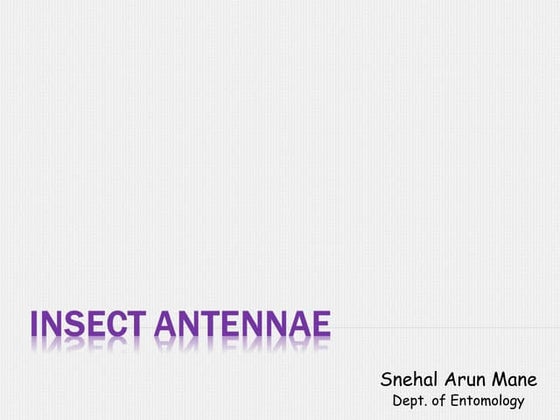



Insect antennaeSnehal mane
╠²
The document discusses the structure and functions of insect antennae. It notes that antennae are borne on the second head segment and function primarily for sensory perception. The main parts of antennae are the scape, pedicel, and flagellum. Antennae allow insects to detect smells, sounds, humidity, mates, food, and danger. Their shape varies between insect orders and can be filiform, setaceous, moniliform, capitate, clavate, lamellate, serrate, pectinate, geniculate, bipectinate, aristate, or stylate depending on the insect. Antennae play important sensory roles in insect behavior and communication.Unit2 Locomotory organs.pptx



Unit2 Locomotory organs.pptxnamrathaparthasarath
╠²
The document discusses the locomotory organs (legs and wings) of insects. It describes the basic body plan of insects, which consists of 3 main body regions - head, thorax, and abdomen. The thorax contains 3 segments that each bear a pair of legs. The legs are typically segmented into 5 parts - coxa, trochanter, femur, tibia, and tarsus. The document outlines different types of leg modifications including saltatorial (jumping), raptorial (seizing), fossorial (digging), cursorial (running), and natatorial (swimming) legs. Each modification is adapted to specific insect behaviors and environments.Insect leg



Insect legJ Roopavathy
╠²
The document discusses the structure and modifications of insect legs. It notes that insect legs consist of six segments - coxa, trochanter, femur, tibia, tarsus, and pretarsus. The legs can be modified for different functions like walking, running, digging, grasping prey, leaping, swimming, and climbing. Examples are given of cursorial legs for running and natatorial legs for swimming. Leg segments can also be modified for tasks like pollen collection in bees or sound production in grasshoppers. Reduction or loss of legs occurs in some sedentary or specialized insects.More Related Content
What's hot (20)
structural organisation of insect body



structural organisation of insect bodyBhubanananda Adhikari
╠²
The document summarizes the structure and segmentation of the insect body. It is divided into three main parts:
1. The head, which is formed from the fusion of seven segments and contains the mouthparts, eyes, and antennae.
2. The thorax, which is composed of three segments - prothorax, mesothorax, and metathorax. Each segment contains a dorsal notum, lateral pleuron, and ventral sternum. The mesothorax and metathorax make up the pterothorax which bears the wings.
3. The abdomen, consisting of 9-11 segments. Each segment contains a dorsal tergum and ventral sternumInsect Leg



Insect LegBhubanananda Adhikari
╠²
Insect legs are segmented and consist of 5 segments - coxa, trochanter, femur, tibia, and tarsus. Legs are modified for different habitats and behaviors, including walking, running, jumping, climbing, digging, grasping, swimming, sticking, basket-like, sucking, and food collecting. The document describes the structure and modifications of each leg type.Insect Sense Organs.pptx



Insect Sense Organs.pptxPrajwal Gowda M.A
╠²
Insect sense organs, definition, type.
Mechanoreceptors- it's types, Auditoryreceptors- it's types,
Chemoreceptors- it's types.INSECTS



INSECTSSnehal mane
╠²
This document provides an overview of insect morphology, anatomy, and classification. It describes the external and internal body structures of insects, including the head, thorax, abdomen, digestive and reproductive systems. It also outlines the key characteristics of the phylum Arthropoda and class Insecta. Examples are provided of the different insect orders. References for further reading on entomology are listed at the end.Insect Genitalia: ItŌĆÖs Structure, functions and modification in different ord...



Insect Genitalia: ItŌĆÖs Structure, functions and modification in different ord...N.m.c.a
╠²
The document discusses the structure and function of insect genitalia. It describes that the abdomen consists of pregenital, genital, and postgenital segments. The female genitalia includes an ovipositor for egg laying that varies between orders. The male genitalia contains phallic organs like the aedeagus and accessory structures for sperm transfer. The structures of the genitalia are adapted for reproduction and show diversity across insect groups.Order orthroptera



Order orthropteraNavneet Mahant
╠²
Orthoptera is an order of insects that comprises the grasshoppers, locusts and crickets, including closely related insects such as the katydids and wetas. The order is subdivided into two suborders: Caelifera ŌĆō grasshoppers, locusts and close relatives; and Ensifera ŌĆō crickets and close relatives.Insect Leg: Structure and Modifications



Insect Leg: Structure and ModificationsVikas Kashyap
╠²
This document describes the different types of modifications that insect legs can undergo. It begins by explaining the basic structure of a typical insect leg, which consists of six segments: the coxa, trochanter, femur, tibia, tarsus, and pretarsus. It then outlines 15 different types of leg modifications, including walking, running, jumping, clinging, digging, grasping, swimming, pollen collecting, sound producing, sticking, clasping, sucking, antenna cleaning, wax picking, and prehensile legs. Each modification type is adapted for a specific purpose and locomotion style. Examples are provided for each leg modification type to illustrate insects that exhibit that trait.WING VENATION IN INSECTS



WING VENATION IN INSECTSPoojaVishnoi7
╠²
’éŚ wing is one of the most characterstic feature of insects.
’éŚ In majority of insects mesothorax and meta thorax carries a pair of wings.
’éŚ On the basis of presence of wings class insecta is devided into 2 sub classes :
1. APTERIGOTA
2. PTERIGOTA
Insect head



Insect headNaga Satyasri Ch
╠²
1. The insect head is a hardened capsule that bears sensory organs like eyes and antennae, as well as feeding appendages around the mouth.
2. It develops from the fusion of six ancestral segments and is divided into an anterior procephalon and posterior gnathocephalon.
3. The procephalon bears the eyes and antennae while the gnathocephalon bears the mandibles, maxillae, and labium used for feeding.Order thysanura (silver fish)



Order thysanura (silver fish)MujahidHussain103
╠²
Silverfish are small, wingless insects that feed on starches and sugars. They have long antennae and move in a wiggling motion. Silverfish lay eggs in cracks and crevices, and go through many molts during their multi-year lifecycles. Though primarily nocturnal and found worldwide in damp areas, some domestic species can damage household goods by feeding on materials like paper and cloth. Integrated pest management of silverfish involves both physical controls like dehumidification and vacuuming, as well as borate-based chemical treatments.Insect Antennae



Insect AntennaeBhubanananda Adhikari
╠²
The document discusses the structure, function, and classification of insect antennae. It notes that antennae are segmented appendages located near the eyes that serve sensory functions. There are three main segments: the scape, pedicel, and flagellum. The flagellum contains many sensory receptors. Antennae can detect chemicals, smells, sounds, temperature, and vibrations. They help with functions like hearing, communication, grasping mates and prey. The document classifies 15 different types of insect antennae based on their structure, such as filiform, pectinate, and geniculate types.Digestive system in insects



Digestive system in insectsMr. Suresh R. Jambagi
╠²
The document discusses the digestive system of insects. It notes that insects have different digestive structures depending on whether they feed on solid foods or liquids. The main parts of the insect digestive system are the foregut, midgut, and hindgut. The foregut includes the mouth, esophagus, crop, and gizzard. The midgut is where most digestion occurs through enzymes secreted by epithelial cells. The hindgut absorbs water and nutrients before waste is excreted through the anus. Certain insects also have symbiotic microbes or structures like a filter chamber that aid their digestion.Mouth parts of Insect



Mouth parts of InsectBhubanananda Adhikari
╠²
The document summarizes the different types of insect mouthparts based on their structure and function. It describes 8 main types: 1) biting and chewing, 2) piercing and sucking (bug type), 3) piercing and sucking (mosquito type), 4) chewing and lapping, 5) rasping and sucking, 6) mandibulosuctorial, 7) sponging, and 8) siphoning. Each type has a distinct structure of the mouthparts that determines how the insect feeds, such as biting solid food, piercing and sucking liquids, lapping nectar, or siphoning plant fluids.Modifications in Insect leg



Modifications in Insect legYuvraj Singh
╠²
Insect legs are modified for different functions:
1. Saltatorial legs are adapted for jumping with elongated femurs and tibias.
2. Raptorial legs are modified for grasping prey with Mantids and ambush bugs as examples.
3. Fossorial legs are adapted for digging with mole crickets and cicada nymphs as examples.Insect thorax : Its areas, structure, function and modification in different ...



Insect thorax : Its areas, structure, function and modification in different ...N.m.c.a
╠²
Insect thorax : Its areas, structure, function and modification in different orders of insect, sutures of tergum, sternum and pleuron and pterothorax
Inscet excretory system



Inscet excretory systemKarunya Institute of technology and sciences
╠²
The excretory system of insects involves several organs that work together to remove nitrogenous waste from the body. The main excretory organs are the Malpighian tubules, which produce a filtrate that selectively reabsorbs water and ions while eliminating waste. For terrestrial insects, the main waste product is uric acid, while aquatic insects excrete ammonia. The filtrate produced by the Malpighian tubules passes to the gut where further modification occurs before excretion, helping to maintain fluid and ion balance in the insect's body.Digestive system of Insects



Digestive system of InsectsMuhammad Irfan Shan
╠²
The document summarizes the digestive system of insects. It describes that insects have a long alimentary canal divided into foregut, midgut, and hindgut. The foregut contains the mouth, pharynx, esophagus, crop, and gizzard. Salivary glands secrete enzymes into the foregut. The midgut is the primary site of digestion and absorption, containing gastric caeca that secrete enzymes. The hindgut absorbs nutrients and forms feces. Digestion involves ingestion, transportation, digestion in the midgut by enzymes, absorption of nutrients, and egestion of waste.Insect leg and their modification 



Insect leg and their modification Arvind Yadav
╠²
This document discusses the structure and modification of insect legs. It notes that all insects have three pairs of legs, which gives them the name hexapods. The basic structure of an insect leg consists of five segments: the coxa, trochanter, femur, tibia, and tarsus. The document describes each segment and provides examples of how legs are modified for different purposes, such as cursorial, ambulatory, saltatorial, fossorial, raptorial, and others.Insect Wings, Structure and their Modifications



Insect Wings, Structure and their ModificationsVikas Kashyap
╠²
This ppt includes a brief summary about the Insect wings, their structure and modifications according to their habit and habitat.Insect antennae



Insect antennaeSnehal mane
╠²
The document discusses the structure and functions of insect antennae. It notes that antennae are borne on the second head segment and function primarily for sensory perception. The main parts of antennae are the scape, pedicel, and flagellum. Antennae allow insects to detect smells, sounds, humidity, mates, food, and danger. Their shape varies between insect orders and can be filiform, setaceous, moniliform, capitate, clavate, lamellate, serrate, pectinate, geniculate, bipectinate, aristate, or stylate depending on the insect. Antennae play important sensory roles in insect behavior and communication.Similar to Insect legs and it's modifications (20)
Unit2 Locomotory organs.pptx



Unit2 Locomotory organs.pptxnamrathaparthasarath
╠²
The document discusses the locomotory organs (legs and wings) of insects. It describes the basic body plan of insects, which consists of 3 main body regions - head, thorax, and abdomen. The thorax contains 3 segments that each bear a pair of legs. The legs are typically segmented into 5 parts - coxa, trochanter, femur, tibia, and tarsus. The document outlines different types of leg modifications including saltatorial (jumping), raptorial (seizing), fossorial (digging), cursorial (running), and natatorial (swimming) legs. Each modification is adapted to specific insect behaviors and environments.Insect leg



Insect legJ Roopavathy
╠²
The document discusses the structure and modifications of insect legs. It notes that insect legs consist of six segments - coxa, trochanter, femur, tibia, tarsus, and pretarsus. The legs can be modified for different functions like walking, running, digging, grasping prey, leaping, swimming, and climbing. Examples are given of cursorial legs for running and natatorial legs for swimming. Leg segments can also be modified for tasks like pollen collection in bees or sound production in grasshoppers. Reduction or loss of legs occurs in some sedentary or specialized insects.Insect leg



Insect legJ Roopavathy
╠²
The document describes the structure and segmentation of insect legs. It notes that insect legs typically consist of 6 segments - the coxa, trochanter, femur, tibia, tarsus, and pretarsus. The coxa attaches to the thorax and can allow either rotary or back-and-forth movement. The femur and tibia are usually the longest segments. The tarsus is often divided into tarsomeres. The pretarsus includes claws and adhesive pads or structures. Insect legs show many adaptations for different functions like walking, running, digging, grasping prey, leaping, swimming, and climbing. Examples are given of modifications in different groups of insects.Introductory Entomology



Introductory EntomologyStudent
╠²
Entomology is the study of insects. Insects have three body segments - head, thorax, and abdomen. They belong to the phylum Arthropoda, whose members have jointed appendages, an exoskeleton, and segmented bodies. The major classes of arthropods are crustaceans, myriapoda, arachnids, and insects. Insects are divided into two subclasses - Apterygota, which lack wings, and Pterygota, which are winged or secondarily wingless. Important orders of insects discussed include Hemiptera, Odonata, Orthoptera, Isoptera, Coleoptera, Diptera, Lepidoptera, andinsects leg structure and modification.pptx



insects leg structure and modification.pptxSaeedullahSeo
╠²
The document summarizes the different types of modifications that insect legs undergo according to the insect's habits and habitats. There are 12 main types of leg modifications described: 1) walking, 2) running, 3) jumping, 4) clinging, 5) digging, 6) grasping, 7) swimming, 8) pollen collecting, 9) sound producing, 10) sticking, 11) antennae cleaning, and 12) prehensile legs. Each modification type is accompanied by an example insect to illustrate the structure and function of the specialized leg.Entomology



EntomologyMuhammad Rehan
╠²
This document discusses insect morphology and classification. It defines entomology as the study of insects and notes they have three body segments and three pairs of legs. Major classes of arthropods are described including characteristics of orders like Apterygota, Pterygota, Hemiptera, Odonata, Orthoptera, Isoptera, Coleoptera, Diptera, Lepidoptera, and Hymenoptera. Insect leg types are outlined including cursorial, saltatorial, raptorial, natatorial, and fossorial. Metamorphosis is defined as the physical development of an animal after birth/hatching.Phylum Arthropoda



Phylum ArthropodaCedrick Modelo
╠²
This document provides an overview of arthropods, which account for over three quarters of all known animal species. It discusses their key defining characteristics, including bilateral symmetry, segmented bodies, jointed legs, and hard exoskeletons. The document explores the diversity and success of arthropods, from their ancestral origins over 500 million years ago to the over one million insect species identified today. It also summarizes the major subgroups of arthropods like insects, spiders, crustaceans, and myriapods.The Insect Chest 



The Insect Chest Amani Riyadh
╠²
The thorax is composed of three segments - the prothorax, mesothorax, and metathorax. The mesothorax and metathorax are enlarged and bear wings and associated musculature. Wings occur on the mesothorax and metathorax. The thorax contains nota (dorsal plates), sterna (ventral plates), and pleura (lateral plates) that form a box-like structure and play an important role in locomotion. Legs occur on each thoracic segment and have six segments - coxa, trochanter, femur, tibia, tarsus, and pretarsus. Leg segments can be modified for different functions likeHexapoda



Hexapodapolinovi
╠²
This document provides an overview of insects, including:
- There are over 1.1 million known insect species, with many more still undiscovered, making insects the most successful and widespread animal group.
- Insects were one of the first terrestrial animal groups, adapting to land over 390 million years ago before most other animals.
- Insects have small bodies, typically under 2.5 cm, but range in size from under 1 mm to over 25 cm. They are found in nearly all habitats on Earth.Different Types of Leg Structures in Insects



Different Types of Leg Structures in Insectswizardxking2014
╠²
Types of legs in Insects, its example and explanation Minibeasts



Minibeastsmonicajohnston
╠²
This short presentation provides the viewer with information on the scary and interesting minibeasts such as arachnids, insects, annelids, crustaceans and many more. The presentation includes interesting facts and picturesChordata aldo michelle



Chordata aldo michellemichelleee007
╠²
The document summarizes key characteristics of the phylum Chordata. It describes the four defining characteristics of chordates as having a notochord, pharyngeal gill slits, a postanal tail, and a hollow dorsal nerve cord. It provides examples of chordate animals like fish, birds, reptiles, amphibians, and mammals. The phylum is divided into the subphyla of Urochordata, Cephalochordata, and Vertebrata. Vertebrata is further divided into classes including mammals, birds, reptiles, and amphibians.Aerial mammals.pptx



Aerial mammals.pptxMona22maurya
╠²
This document discusses different types of aerial locomotion in animals, including gliding and flapping flight. It provides examples of gliding mammals like flying squirrels and flying lemurs that can glide between trees. Their bodies are adapted with parachute-like membranes between their limbs that allow gliding. The document also describes bats as the only true flying mammals that flap their highly adapted wing membranes to fly. Bats have skeletal, muscular and sensory adaptations like echolocation that allow sustained flapping flight and navigation in darkness.Phylum Chordata



Phylum Chordatakhannea21
╠²
This document describes the characteristics of chordates and their classification. It notes that chordates possess pharyngeal slits, a post-anal tail, and a notochord. Chordates are divided into invertebrate chordates, which retain the notochord throughout life, and vertebrate chordates, which replace the notochord with vertebrae. Vertebrates are further divided into seven classes - Agnatha, Chondrichthyes, Osteichthyes, Amphibia, Reptilia, Aves, and Mammalia. Mammals are the only group to possess mammary glands and are divided into three subclasses - Monotremata, which lay eggs;Arthropods



ArthropodsMichelle Salvador
╠²
This document provides an overview of arthropods and crustaceans. It begins by defining arthropods as animals with a hard exoskeleton, jointed body and limbs, and includes insects, crustaceans, and arachnids. Arthropods are the most successful and diverse animal group. The document then discusses characteristics of arthropods like bilateral symmetry, segmented bodies, exoskeletons, and life cycles. It also summarizes the five major groups of arthropods and how they evolved. Finally, it provides details on specific types of crustaceans like krill, shrimp, lobsters, crabs, crayfish, and barnacles.Classification of Organisms.pptx



Classification of Organisms.pptxDutch5
╠²
This document provides information about classification of organisms. It discusses the key features used to classify organisms into taxonomic groups such as species, genera, kingdoms. It outlines several kingdoms including Animalia, Plantae, Fungi, Protista and Prokaryota. Within the animal kingdom, it describes characteristics of major phyla including arthropods, chordates and their classes. It also discusses the binomial nomenclature system and provides examples of scientific names.LIFE PROCESSES IN A GRASSHOPPER



LIFE PROCESSES IN A GRASSHOPPERAbdulHameeedAbubakar
╠²
This document discusses the life processes of grasshoppers. It describes grasshoppers as herbivorous insects found in green vegetation that undergo incomplete metamorphosis from egg to nymph to adult. The body of a grasshopper has three divisions - head, thorax, and abdomen. The hind legs are elongated and powerful for jumping. Females lay eggs in the soil which hatch as wingless nymphs and progress through six stages before becoming winged adults. Grasshoppers can be economically important as both a food source and agricultural pest.Practical 3: Types of Insect Antennae and Legs.pptx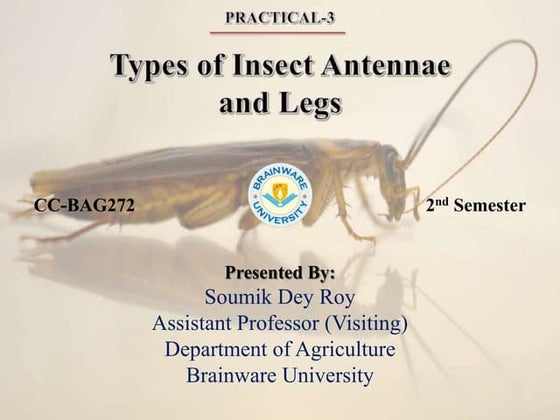



Practical 3: Types of Insect Antennae and Legs.pptxSoumik Dey Roy
╠²
This PowerPoint presentation is for understanding the structure and modifications of insect antennae and legs.Amphibians



AmphibiansAreejTariq
╠²
This document provides information about the external structure, locomotion, nutrition, and digestive system of amphibians. It discusses their smooth skin, lack of scales/feathers/hair, and aquatic larva stage. It describes the three orders of amphibians - Caudata, Gymnophiona, and Anura - and gives examples of salamanders, caecilians, frogs, and toads. It details their skeletal structure and muscular modifications that allow for different modes of locomotion. It also explains their carnivorous or herbivorous diets depending on life stage and describes their flip-and-grab feeding mechanism using their extendable tongues.Recently uploaded (20)
Comprehensive Guide to Antibiotics & Beta-Lactam Antibiotics.pptx



Comprehensive Guide to Antibiotics & Beta-Lactam Antibiotics.pptxSamruddhi Khonde
╠²
¤ōó Comprehensive Guide to Antibiotics & Beta-Lactam Antibiotics
¤ö¼ Antibiotics have revolutionized medicine, playing a crucial role in combating bacterial infections. Among them, Beta-Lactam antibiotics remain the most widely used class due to their effectiveness against Gram-positive and Gram-negative bacteria. This guide provides a detailed overview of their history, classification, chemical structures, mode of action, resistance mechanisms, SAR, and clinical applications.
¤ōī What YouŌĆÖll Learn in This Presentation
Ō£ģ History & Evolution of Antibiotics
Ō£ģ Cell Wall Structure of Gram-Positive & Gram-Negative Bacteria
Ō£ģ Beta-Lactam Antibiotics: Classification & Subtypes
Ō£ģ Penicillins, Cephalosporins, Carbapenems & Monobactams
Ō£ģ Mode of Action (MOA) & Structure-Activity Relationship (SAR)
Ō£ģ Beta-Lactamase Inhibitors & Resistance Mechanisms
Ō£ģ Clinical Applications & Challenges.
¤ÜĆ Why You Should Check This Out?
Essential for pharmacy, medical & life sciences students.
Provides insights into antibiotic resistance & pharmaceutical trends.
Useful for healthcare professionals & researchers in drug discovery.
¤æē Swipe through & explore the world of antibiotics today!
¤öö Like, Share & Follow for more in-depth pharma insights!Chapter 2. Strategic Management: Corporate Governance.pdf



Chapter 2. Strategic Management: Corporate Governance.pdfRommel Regala
╠²
This course provides students with a comprehensive understanding of strategic management principles, frameworks, and applications in business. It explores strategic planning, environmental analysis, corporate governance, business ethics, and sustainability. The course integrates Sustainable Development Goals (SDGs) to enhance global and ethical perspectives in decision-making.Mastering Soft Tissue Therapy & Sports Taping



Mastering Soft Tissue Therapy & Sports TapingKusal Goonewardena
╠²
Mastering Soft Tissue Therapy & Sports Taping: Pathway to Sports Medicine Excellence
This presentation was delivered in Colombo, Sri Lanka, at the Institute of Sports Medicine to an audience of sports physiotherapists, exercise scientists, athletic trainers, and healthcare professionals. Led by Kusal Goonewardena (PhD Candidate - Muscle Fatigue, APA Titled Sports & Exercise Physiotherapist) and Gayath Jayasinghe (Sports Scientist), the session provided comprehensive training on soft tissue assessment, treatment techniques, and essential sports taping methods.
Key topics covered:
Ō£ģ Soft Tissue Therapy ŌĆō The science behind muscle, fascia, and joint assessment for optimal treatment outcomes.
Ō£ģ Sports Taping Techniques ŌĆō Practical applications for injury prevention and rehabilitation, including ankle, knee, shoulder, thoracic, and cervical spine taping.
Ō£ģ Sports Trainer Level 1 Course by Sports Medicine Australia ŌĆō A gateway to professional development, career opportunities, and working in Australia.
This training mirrors the Elite Akademy Sports Medicine standards, ensuring evidence-based approaches to injury management and athlete care.
If you are a sports professional looking to enhance your clinical skills and open doors to global opportunities, this presentation is for you.Dot NET Core Interview Questions PDF By ScholarHat



Dot NET Core Interview Questions PDF By ScholarHatScholarhat
╠²
Dot NET Core Interview Questions PDF By ScholarHatHow to create security group category in Odoo 17



How to create security group category in Odoo 17Celine George
╠²
This slide will represent the creation of security group category in odoo 17. Security groups are essential for managing user access and permissions across different modules. Creating a security group category helps to organize related user groups and streamline permission settings within a specific module or functionality.AI and Academic Writing, Short Term Course in Academic Writing and Publicatio...



AI and Academic Writing, Short Term Course in Academic Writing and Publicatio...Prof. (Dr.) Vinod Kumar Kanvaria
╠²
AI and Academic Writing, Short Term Course in Academic Writing and Publication, UGC-MMTTC, MANUU, 25/02/2025, Prof. (Dr.) Vinod Kumar Kanvaria, University of Delhi, vinodpr111@gmail.comDr. Ansari Khurshid Ahmed- Factors affecting Validity of a Test.pptx



Dr. Ansari Khurshid Ahmed- Factors affecting Validity of a Test.pptxKhurshid Ahmed Ansari
╠²
Validity is an important characteristic of a test. A test having low validity is of little use. Validity is the accuracy with which a test measures whatever it is supposed to measure. Validity can be low, moderate or high. There are many factors which affect the validity of a test. If these factors are controlled, then the validity of the test can be maintained to a high level. In the power point presentation, factors affecting validity are discussed with the help of concrete examples.Azure Data Engineer Interview Questions By ScholarHat



Azure Data Engineer Interview Questions By ScholarHatScholarhat
╠²
Azure Data Engineer Interview Questions By ScholarHatFull-Stack .NET Developer Interview Questions PDF By ScholarHat



Full-Stack .NET Developer Interview Questions PDF By ScholarHatScholarhat
╠²
Full-Stack .NET Developer Interview Questions PDF By ScholarHatIntellectual Honesty & Research Integrity.pptx



Intellectual Honesty & Research Integrity.pptxNidhiSharma495177
╠²
Research Publication & Ethics contains a chapter on Intellectual Honesty and Research Integrity.
Different case studies of intellectual dishonesty and integrity were discussed.Bß╗ś TEST KIß╗éM TRA GIß╗«A K├ī 2 - TIß║ŠNG ANH 10,11,12 - CHUß║©N FORM 2025 - GLOBAL SU...



Bß╗ś TEST KIß╗éM TRA GIß╗«A K├ī 2 - TIß║ŠNG ANH 10,11,12 - CHUß║©N FORM 2025 - GLOBAL SU...Nguyen Thanh Tu Collection
╠²
https://app.box.com/s/ij1ty3vm7el9i4qfrr41o756xycbahmgMeeting the needs of modern students?, Selina McCoy



Meeting the needs of modern students?, Selina McCoyEconomic and Social Research Institute
╠²
NAPD Annual Symposium
ŌĆ£Equity in our Schools: Does the system deliver for all young people?ŌĆØEffective Product Variant Management in Odoo 18



Effective Product Variant Management in Odoo 18Celine George
╠²
In this slide weŌĆÖll discuss on the effective product variant management in Odoo 18. Odoo concentrates on managing product variations and offers a distinct area for doing so. Product variants provide unique characteristics like size and color to single products, which can be managed at the product template level for all attributes and variants or at the variant level for individual variants.Inventory Reporting in Odoo 17 - Odoo 17 Inventory App



Inventory Reporting in Odoo 17 - Odoo 17 Inventory AppCeline George
╠²
This slide will helps us to efficiently create detailed reports of different records defined in its modules, both analytical and quantitative, with Odoo 17 ERP.How to Configure Deliver Content by Email in Odoo 18 Sales



How to Configure Deliver Content by Email in Odoo 18 SalesCeline George
╠²
In this slide, weŌĆÖll discuss on how to configure proforma invoice in Odoo 18 Sales module. A proforma invoice is a preliminary invoice that serves as a commercial document issued by a seller to a buyer.How to Configure Proforma Invoice in Odoo 18 Sales



How to Configure Proforma Invoice in Odoo 18 SalesCeline George
╠²
In this slide, weŌĆÖll discuss on how to configure proforma invoice in Odoo 18 Sales module. A proforma invoice is a preliminary invoice that serves as a commercial document issued by a seller to a buyer.Odoo 18 Accounting Access Rights - Odoo 18 ║▌║▌▀Żs



Odoo 18 Accounting Access Rights - Odoo 18 ║▌║▌▀ŻsCeline George
╠²
In this slide, weŌĆÖll discuss on accounting access rights in odoo 18. To ensure data security and maintain confidentiality, Odoo provides a robust access rights system that allows administrators to control who can access and modify accounting data. AI and Academic Writing, Short Term Course in Academic Writing and Publicatio...



AI and Academic Writing, Short Term Course in Academic Writing and Publicatio...Prof. (Dr.) Vinod Kumar Kanvaria
╠²
Bß╗ś TEST KIß╗éM TRA GIß╗«A K├ī 2 - TIß║ŠNG ANH 10,11,12 - CHUß║©N FORM 2025 - GLOBAL SU...



Bß╗ś TEST KIß╗éM TRA GIß╗«A K├ī 2 - TIß║ŠNG ANH 10,11,12 - CHUß║©N FORM 2025 - GLOBAL SU...Nguyen Thanh Tu Collection
╠²
Insect legs and it's modifications
- 1. Insect legs and it's modifications IMRAN UL HASSAN SOLANGI Session 2019-20 Department of Zoology Shah Abdul Latif University (SALU) Khairpur
- 2. CONTENT ’üĄIntroduction of Insects of legs ’üĄStructure of typical insect legs ’üĄTYPES OF INSECTŌĆÖS LEGS ’éĘ Saltatorial ŌĆö jumping ’éĘ Raptorial ŌĆö seizing ’éĘ Fossorial ŌĆö digging ’éĘ Natatorial ŌĆö swimming ’éĘ Cursorial ŌĆö running ’éĘ Scansoria --- Climbing ’éĘ Ambulatorial --- walking
- 3. Insect Legs:- Insect have three pairs of legs, one pair on each of the three segments of the thorax and are generally called the fore-, mid-, and hind legs. Any of the pairs of legs may be heavily modified and are important for locomotion, prey capture, mating, etc. Thankfully, just like mouthparts, all insect legs contain the same basic parts. From proximal (toward or against the body) to distal (away from the body) the parts of an insect leg are: coxa, trochanter, femur, tibia, and tarsus. The tarsus almost always has one or two claws at the type used to grasp the substrate. The figure Insect Legs, right, shows legs modified for numerous purposes: A, running; B, jumping; C, digging; D, grasping; E, catching; F, walking and digging; G, reduced leg used for walking and digging; H, male leg modified for grasping females during mating. Abdominal Prolegs Some insect larvae, such as caterpillars, have pairs of short fleshy legs on one or more abdominal segments. These legs may have tiny hooks or barbs (called crochets) that serve to grip the substrate. Abdominal prolegs never occur in an insectŌĆÖs adult stage. They are a unique larval adaptation derived from a completely different embryological origin than the thoracic legs.
- 4. Structure of typical insect legs Consist of 5 segments namely Coxa , trochanter, femur , tibia and tarsus .Tarsus consist of 1-5 small segments called tarsomeres.Last tarsomere bears a pair of claws A pad between the claws is called Arolium Pads at the base of claws are called pulvilli. While the legs are normally adapted for walking many insects have them modified for variety of functions.Various modifications are Saltatorial legs ŌĆōHind legs adapted for leaping of jumping . The femur is greatly enlarged giving articulation for large muscles of tibia which are used in jumping occur in Grasshopper,Cricket. The term pretarsus refers to the terminal segment of the tarsus and any other structures attached to it, including: ’éĘ ungues ŌĆö a pair of claws ’éĘ arolium ŌĆö a lobe or adhesive pad between the claws ’éĘ empodium ŌĆö a large bristle (or lobe) between the claws ’éĘ pulvilli ŌĆö a pair of adhesive pads
- 5. TYPES OF INSECTŌĆÖS LEGS ’éĘ Saltatorial ŌĆö jumping ’éĘ Raptorial ŌĆö seizing ’éĘ Fossorial ŌĆö digging ’éĘ Natatorial ŌĆö swimming ’éĘ Cursorial ŌĆö running ’éĘ Scansoria --- Climbing ’éĘ Ambulatorial --- walking Saltatorial: (Salatorial = Leaping : Jumping Leg) Saltatorial legs are jumping legs. YouŌĆÖve all seen these kinds of legs before! Grasshoppers are the poster insects for saltatorial legs, but other jumping insects like fleas have them as well. Saltatorial legs work well for jumping because they are enlarged legs filled with bulky, strong muscles. All those muscles allow insects with this type of leg to jump, propelling themselves forward very long distances very quickly. Saltatorial legs are usually hind legs. e.g. hind leg of grasshopper. Raptorial: (Raptorial = predatory ; Grasping leg) You are likely familiar with this sort of leg too. Raptorial legs are hunting legs, the kinds of legs you see on predatory insects such as mantids and giant water bugs. Like the saltatorial legs, these are enlarged legs full of strong, powerful muscles. However, these legs are usually at the front of the insect and are used to grab and hold prey while they eat. Many insects with raptorial legs hold them out in front of their bodies, positioned so that they can strike at prey at any time. e.g. Forelegs of preying mantis.
- 6. Fossorial: (Fossorial = Digging; Burrowing leg) Insects with fossorial legs live underground and use their highly modified legs, usually the forelegs, to dig burrows. The mole cricket, the forlegs of which are pictured at left, are a prime example. Fossorial legs tend to be very broad, very flat, and very dense. They often have big, strong claws. Fossorial legs work somewhat like shovels to rip soils apart quickly and easily and allow the insect to bury itself in the ground surprisingly quickly. This type of leg is much less common than the others, but itŌĆÖs a thrill to find an insect that has them! TheyŌĆÖre really impressive. e.g. Fore legs of mole cricket. Natatorial: (Natatorial = pertaining to swimming; Swimming leg) Natatorial is another word for swimming, so insects with natatorial legs are aquatic insects that require modified legs to move easily through water. Natatorial legs are often flattened, broad, and fringed with dense hairs, as in the image of the predaceous diving beetle hind leg pictured at right. These adaptations have the same sort of effect as a human wearing flippers as they swim ŌĆō they increase the surface area of the legs as they kick, allowing the insect to move more easily through water. Many aquatic insects exhibit natatorial legs, especially in the hind and middle pairs of legs, but not all of them do. They are especially common in aquatic beetles and bugs. e.g. hing legs of water bug and water beetle.
- 7. Cursorial: (Cursorial = adapted for running : Running leg) These are the types of legs most people likely think of if theyŌĆÖve ever pondered insect legs before. Cursorial is a fancy word for running, so these are the kinds of legs you see on swiftly moving insects such as roaches and tiger beetles. Cursorial legs tend to be long and narrow and are designed so that the insect can move very quickly. Things with this type of leg are often hard to catch ŌĆō or hard to step on if youŌĆÖre dealing with roaches. e.g. All the three pairs of legs of cockroach. Legs are suited for running. Femur is not swollen. Ambulatorial (Ambulate - to walk; Walking leg) e.g. Fore leg and middle leg of grasshopper. Femur and tibia are long. Legs are suited for walking. Scansorial: (Scansorial = Climbing; climbing or clinging leg) e.g. all the three pairs of legs of head louse.
- 8. REFERENCES: Introduction : https://wiki.bugwood.org/Insect_Biology https://wiki.bugwood.org/File:Insect_legs.jpg https://genent.cals.ncsu.edu/bug-bytes/thorax/legs/ Structure of typical insect legs: /ARUN5218/insect-legs-and-its-modifications TYPES OF INSECTŌĆÖS LEGS: https://wwwthedragonflywoman.com/2010/12/10/insect-legs/ https://slideplayer.com/slide/4419531/ https://genent.cals.ncsu.edu/wp-content/themes/salient/img/labs/cursorial.jpg https://genent.cals.ncsu.edu/wp-content/themes/salient/img/extanat/prolegs.gif



